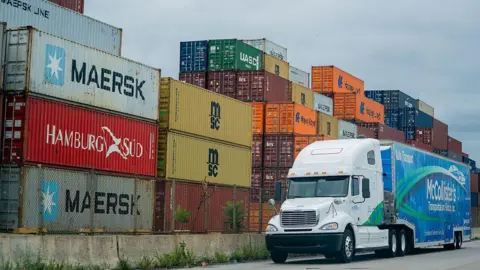In recent developments concerning the economy of the United States, the wholesale prices in the country surged significantly in July 2025, marking the most substantial increase in over three years. This rise in prices is intricately linked to the new tariffs that have been imposed by the administration of former President Donald Trump. Such tariffs have altered the pricing landscape for various goods, creating a ripple effect on the overall economy.
The data provided by the Labor Department indicated that the producer price index (PPI), which gauges the selling prices that producers obtain for their goods and services, saw an increase of 0.9% from June to July. In contrast, the prior month had reported stagnation in these prices. This leap in wholesale prices was considerably higher than the expectations set by analysts, who had forecasted a mere 0.2% increase. Consequently, this trend raised alarms regarding the potential for rising consumer prices across the nation, as businesses may pass the cost increases on to consumers.
Despite these alarming statistics surrounding wholesale prices, the report revealed that the increase in consumer prices had remained stable at a modest 2.7% for July. Nevertheless, the implications of the sharp rise in wholesale prices have reignited concerns about inflation, particularly in a climate that requires vigilance from economic policymakers.
Analysts have expressed apprehension regarding the implications of these rising inflation indicators on the Federal Reserve’s ability to make independent monetary policy decisions. The Federal Reserve, which is responsible for setting interest rates in the U.S., might face mounting difficulties in addressing calls from the Trump administration to cut interest rates. Trump has been vocally advocating for such cuts in an effort to stimulate economic growth. However, the Fed operates independently and remains cautious about decreasing interest rates while inflationary pressures escalate due to rising tariffs.
The continuous pressure on interest rates has become an intricate balancing act; while there is weak job growth and inflation trends that may tempt the Fed to lower borrowing costs, the complications introduced by tariffs are decidedly concerning. Earlier in the week, Treasury Secretary Scott Bessent urged the Fed to consider reducing its key lending rate by half a percentage point during the upcoming September meeting, highlighting the pressure to stimulate the economy.
Matthew Martin, a senior U.S. economist at Oxford Economics, succinctly noted the conundrum that the Federal Reserve faces, indicating that the unexpected rise in producer prices complicates decision-making regarding interest rates. Martin further emphasized that while inflation remains below the Fed’s target, projections indicated that it could escalate in the coming months.
The report from July highlighted other notable aspects of the PPI, including a significant 1.1% rise in wholesale prices for services, which encompasses sectors such as warehousing and investment advisory services. Goods prices also rose by 0.7%, with the increase driven largely by escalating food costs. Categories directly impacted by tariffs, including home furniture and apparel items, reflected substantial price hikes as well.
Samuel Tombs, the chief U.S. economist at Pantheon Macroeconomics, reflected on these developments by stating, “New tariffs are continuing to generate cost pressures in the supply chain, which consumers will shoulder soon.” This means that as production costs rise, the burden is likely to fall on consumers, affecting their purchasing power.
In summary, the rise in U.S. wholesale prices recorded in July provides essential insight into current economic challenges, particularly in the context of tariffs and their inflationary effects on the market. Analysts remain concerned about the potential consequences this could have for consumer prices and Federal Reserve policy decisions, as they navigate the delicate balance of fostering economic growth while managing inflation in an increasingly complex economic landscape.












